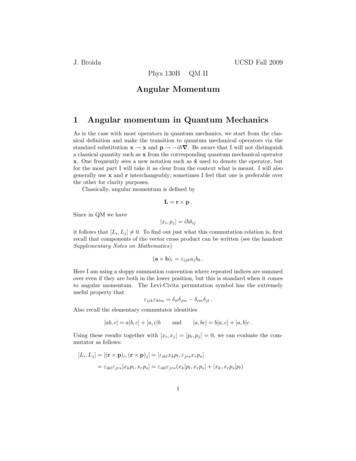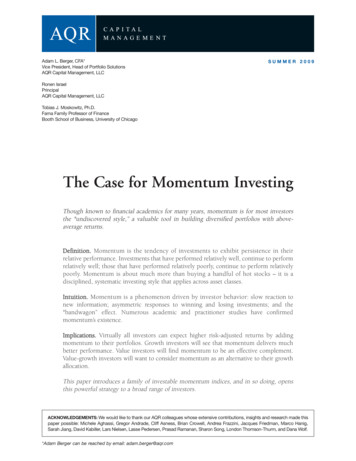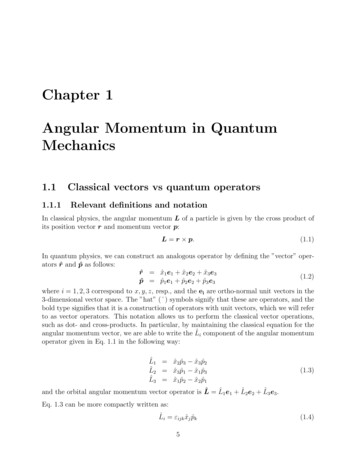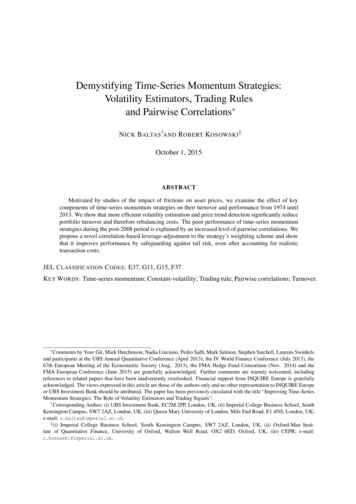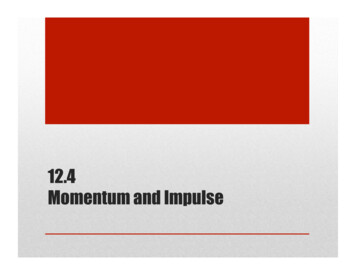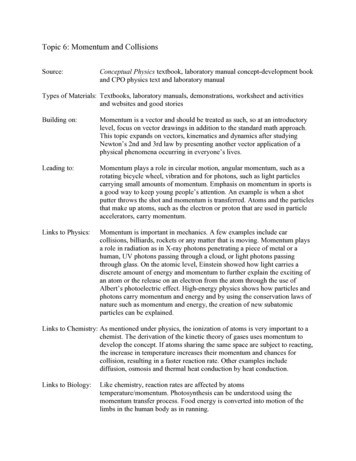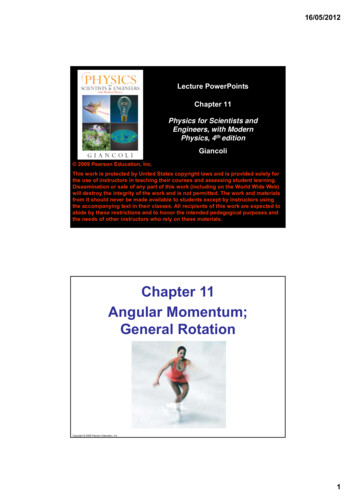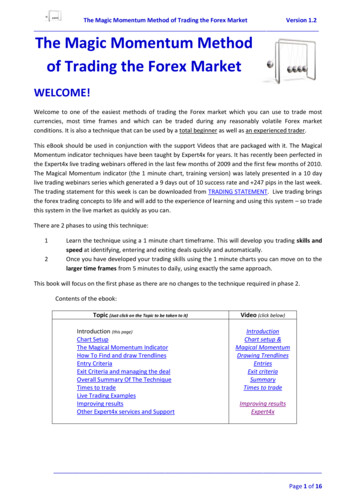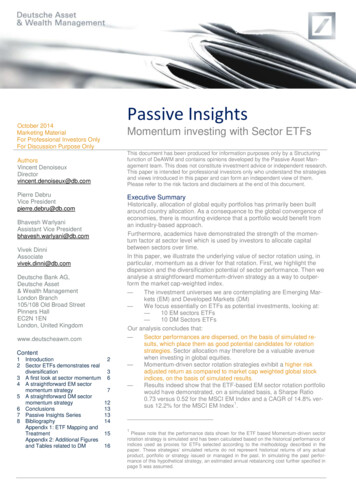
Transcription
Passive InsightsOctober 2014Marketing MaterialFor Professional Investors OnlyFor Discussion Purpose OnlyMomentum investing with Sector ETFsThis document has been produced for information purposes only by a Structuringfunction of DeAWM and contains opinions developed by the Passive Asset Management team. This does not constitute investment advice or independent research.This paper is intended for professional investors only who understand the strategiesand views introduced in this paper and can form an independent view of them.Please refer to the risk factors and disclaimers at the end of this document.AuthorsVincent DenoiseuxDirectorvincent.denoiseux@db.comPierre DebruVice Presidentpierre.debru@db.comExecutive SummaryBhavesh WarlyaniAssistant Vice Presidentbhavesh.warlyani@db.comVivek DinniAssociatevivek.dinni@db.comDeutsche Bank AG,Deutsche Asset& Wealth ManagementLondon Branch105/108 Old Broad StreetPinners HallEC2N 1ENLondon, United ionSector ETFs demonstrates realdiversificationA first look at sector momentumA straightforward EM sectormomentum strategyA straightforward DM sectormomentum strategyConclusionsPassive Insights SeriesBibliographyAppendix 1: ETF Mapping andTreatmentAppendix 2: Additional Figuresand Tables related to DM2367121313141516Historically, allocation of global equity portfolios has primarily been builtaround country allocation. As a consequence to the global convergence ofeconomies, there is mounting evidence that a portfolio would benefit froman industry-based approach.Furthermore, academics have demonstrated the strength of the momentum factor at sector level which is used by investors to allocate capitalbetween sectors over time.In this paper, we illustrate the underlying value of sector rotation using, inparticular, momentum as a driver for that rotation. First, we highlight thedispersion and the diversification potential of sector performance. Then weanalyse a straightforward momentum-driven strategy as a way to outperform the market cap-weighted index.—The investment universes we are contemplating are Emerging Markets (EM) and Developed Markets (DM)—We focus essentially on ETFs as potential investments, looking at:—10 EM sectors ETFs—10 DM Sectors ETFsOur analysis concludes that:—Sector performances are dispersed, on the basis of simulated results, which place them as good potential candidates for rotationstrategies. Sector allocation may therefore be a valuable avenuewhen investing in global equities.—Momentum-driven sector rotation strategies exhibit a higher riskadjusted return as compared to market cap weighted global stockindices, on the basis of simulated results.—Results indeed show that the ETF-based EM sector rotation portfoliowould have demonstrated, on a simulated basis, a Sharpe Ratio0.73 versus 0.52 for the MSCI EM Index and a CAGR of 14.8% ver1sus 12.2% for the MSCI EM Index .1Please note that the performance data shown for the ETF based Momentum-driven sectorrotation strategy is simulated and has been calculated based on the historical performance ofindices used as proxies for ETFs selected according to the methodology described in thepaper. These strategies’ simulated returns do not represent historical returns of any actualproduct, portfolio or strategy issued or managed in the past. In simulating the past performance of this hypothetical strategy, an estimated annual rebalancing cost further specified inpage 5 was assumed.
Passive Insights——Results indeed show that the ETF-based DM sector rotation portfolio would have demonstrated, on a simulated basis, a Sharpe Ratio0.27 versus 0.15 for the MSCI DM Index and a CAGR of 6.2% versus 4.4% for the MSCI DM Index.Sector ETFs may enable the implementation of such a momentumstrategy in a straightforward, cheap and liquid way.1 IntroductionAllocation in a global Equity universe is a tough topic. There is no easychoice between focusing on stock picking, country allocation or sectorallocation. Historically, a lot of practitioners approached this problemthrough a national or regional prism first; the implicit assumption for thisbeing that the benefits of international diversification outweigh the benefitsof intra-country dispersion and, in particular, inter-sector diversification. Asa result, the historical dominance of the country effect has beendecreasing with the integration of global economies and country effects nolonger dominate sector effects (Baca, Garbe and Weiss [2000]). The firstpart of this paper aims to illustrate how the different sector performancesand characteristics differ significantly over time and the diversificationpotential that lies in a sector-based allocation.In previous papers, we have studied systematic passive ETF-focusedstrategies to unlock the potential performance of several top-downapproaches. In particular, we looked at low volatility portfolios as well as2equal weight portfolios of sector ETFs . Both strategies demonstratedattractive risk return profiles, on the basis of simulated results. Based onthis analysis, they also showed performances similar to theircorresponding stock-based strategies that would require significantly moreoperational work. Medium-term stock momentum has been researchedwidely by both researchers and practitioners over the years as an anomalythat did generate positive returns over time. Researchers have indeedspent a significant amount of resources to investigate this strategy, itsrobustness, its causes, as well as its implications on market efficiency.One of their important findings has been that stock level momentum canbe captured at sector level (Moskowitz and Grinblatt [1999], O'Neal[2000]).Finally, in the third part of the paper we suggest one implementation of amomentum-based sector rotation strategy. As we implement this strategyon a global universe, country-specific effects are mitigated to a certainextent making these strategies focus solely on sector rotation. We will alsolook at the many advantages and potential drawbacks of this strategy indetail.When it comes to implementing such a strategy, it is important to properlychoose the tradable instruments that will be used. Here, we have indeedfocused on ETFs.1.1 Case for using ETFs to build Sector RotationStrategies— Allocation into sectors rather than single stocks demonstratessimilar benefits as its single stock equivalent;2“Smart Beta: Building Low Volatility Portfolios of ETFs”, Journal of Index Investing, 2014“Equal Weighted Portfolios of ETFs”, Passive Insights #3, Summer 20142Momentum investing with Sector ETF 10.10.2014
Passive Insights— Accessibility through relatively cheap and liquid instruments;— Straightforward, easy to monitor portfolios of 10 sector basedETFs (as compared with hundreds of stocks).1.2 A challenge in implementing Sector RotationStrategiesHigher turnover: periodical rebalancing of the portfolio maysignificantly increase the turnover which translates in highertransaction costs.—2 Sector ETFs demonstrates real diversificationUnless otherwise specified, we use Sectors for Developed and EmergingMarkets to implement the strategies described herein.Hereafter we look in particular at the MSCI Emerging Market (EM) Sectorsand the MSCI World Developed Market (DM) Sectors universe.Universe of Emerging Market Sectors: EM Consumer Discretionary, EMConsumer Staples, EM Energy, EM Financials, EM Healthcare, EMIndustrials, EM Information and Technology, EM, Materials, EM Telecomand EM Utilities.Universe of World Market Sectors: DM Consumer Discretionary, DMConsumer Staples, DM Energy, DM Financials, DM Healthcare, DMIndustrials, DM Information and Technology, DM Materials, DM Telecomand DM Utilities3As illustrated in Figure 1 , there seems to be no apparent relationshipbetween the year-on-year performances of each EM sector. This sectordispersion is indeed very important. Should one benefit from perfectforesight, by investing in the top performing sector each year, it would beeasy to significantly outperform the market.Looking further into the performance dispersion between sector indices,we look at the general correlation between the EM sectors, as shown in4Figure 2 . Some sectors such as IT and Utilities, for example, demonstratelow correlation but overall the correlations are still relatively high. Eachsector still exhibits a significant beta. To isolate the impact performance ofthe sector from that of the market, we strip the performance of the overallbenchmark from the performance of each sector. We then calculate thecorrelation matrix of the excess returns of each sector. As shown in Figure53 , it is much clearer from this analysis that the excess returns are fairlyuncorrelated. This could therefore allow an investor to benefit from apotentially stronger diversification effect when building a sector basedportfolio, relative to the benchmark.3Source: Deutsche Bank, Bloomberg. Yearly performance of ten MSCI Emerging Market NetTR Sector Indices.4Source: Deutsche Bank, Bloomberg. Correlation using daily returns for the period: Dec2000 to Jul 2014.5Source: Deutsche Bank, Bloomberg. Correlation using daily sector excess returns for theperiod: Dec 2000 to Jul 2014. Sector Excess Returns is a term used to describe EMSpecific Sector Returns minus MSCI EM Net TR Returns.3Momentum investing with Sector ETF 10.10.2014
Passive InsightsWith regards to the DM sectors, year-on-year performance of sectorsseems fairly dispersed, in accordance with the findings for the EM sectors.However, the difference between the best and worst performer of the yearis lower as compared with the EM sectors. DM sectors still exhibit verystrong dispersion in line with what is observed for EM sectors in Figure 2and Figure 3. Please see Figure 23, Figure 24 and Figure 25 in theappendixYearly performance of EM Sectors shows relative dispersion1Yearly performance of Emerging Market SectorsLegendCDCSEGConsumer Discretionary (Cyclical)Consumer Staples (Defensive)Energy (Defensive)INDITMLFINFinancials (Cyclical)TSHCHealthcare (Defensive)ULIIndustrials (Cyclical)Information Technology (Cyclical)Materials (Cyclical)Telecommunication Services(Defensive)Utilities (Defensive)Inter-sector Correlation is limitedCorrelation between Total Returns of individual EM sectors2Correlation between Excess Returns of individual EM sectors3Cyclical vs Defensive sectorsOver time, some sectors have been classified by academics andpractitioners as defensive and others as cyclical in response to theirbehaviour at different stages of market cycles. Cyclical sectors aredeemed to perform better during bull cycles whereas defensive sectors aredeemed to perform better during bear markets. This dual behaviour is fairlywell demonstrated by the rotation of the best and worst performers inFigure 1.4Momentum investing with Sector ETF 10.10.2014
Passive InsightsIt can also be illustrated by looking at the volatility and the beta (versus the67EM index) of the sectors as illustrated below in Figure 4 and 5 .In Figure 4, we calculated the 1Y rolling volatility of each of the EM sectorsand printed the minimum and maximum 1Y volatility realized as well as theyear of occurrence of these troughs and peaks of volatility.This analysis shows that cyclical sectors demonstrate significant volatilityvariations over time while defensive sectors show relatively smallerchanges. It is also interesting to note that individual sectors do not exhibita low/high volatility regime at the same time of the cycle (with the notableexception of the 2008 crisis).In Figure 5, we study the 1Y rolling Beta of the EM Sectors. Similarly to thevolatility analysis, some sectors exhibit above average beta (which can beconsidered as “cyclical”) and others demonstrate below average betas(which can be considered as “defensive”). Both beta and volatility exhibitstrong variations over time in line with business cycles. For example,variation in volatility became more prominent during stressed marketconditions of 2002 and 2008.In this instance also, results for both developed and emerging markets arevery similar. DM sectors exhibit cyclical or defensive behaviors with largevariations in volatility across time. Please see Figure 26 and Figure 27 formore information in the appendix.Range of 1-Year Realized Volatilty for EM Sectors observed in various periods60%20082008200850%200820082008Min and Max ndustrials200510%Cons.Disc.20%Fin.1-Year Volatilty4EnergyMaterialsI.T.0%Variation of Beta of EM Sectors over observation period52.295 %ile5 0.2IT1-Year Beta observationsMax and Min1.86Source: Deutsche Bank, Bloomberg. 1-Year volatility using daily returns is calculated at theend of each year. Observation period: Dec 2000 to Dec 2013.7Source: Deutsche Bank, Bloomberg. 1-Year beta using daily returns for the period: Dec2000 to Jul 2014. Proxy for market: MSCI EM TR Net Index. Avg. Beta is calculated withmonthly observations of 1-Year beta.5Momentum investing with Sector ETF 10.10.2014
Passive InsightsAs described above, industry performance is dispersed and, therefore, onecould use, if properly implemented, these sectors within a rotation strategywith good results. However, to unlock this potential, one needs to thinkcarefully about their investment strategy to try to allocate capital to theright sector at the right moment.In this paper we propose to use a straightforward momentummethodology.3 A first look at sector momentumMomentum is an empirically observed phenomenon based on the theorythat high performing securities will continue to perform well and thatunderperforming securities will continue to underperform. Academics havelargely attributed this phenomenon to behavioural biases such as investorherding, investor over–and-under reaction and confirmation bias. Amomentum strategy will buy or overweight (or, alternatively, sell orunderweight) securities which have performed well (or, alternatively,poorly) in the past for a particular observation period.In this section, we use the methodology supported by Jegadeesh andTitman [1993], to illustrate the existence of strong momentum in SectorIndices.The methodology observes the excess returns over an observation periodof a certain number of months (1M, 3M and 6M) and shows the excessreturns realized over the following period of Y months (1M, 3M). The8numbers tabulated in Figure 6 show the percentage of total observationsin which the positive (or negative respectively) excess returns realizedduring the observation period are followed by positive (or negativerespectively) excess returns realized during the following period.Excess return is defined as a sector’s performance over the period minusthe average performance of all the sectors for the same period. Whencalculating the ratio for the MSCI EM Index, absolute returns areconsidered instead of excess returns.Out of all the multiple observation and realization periods, 47 out of a totalof 60 past observations are exhibiting a hit ratio greater than 50%, whichmay be considered a relatively clear indication of a momentum effect insectors in the past.6Percentage of total observations exhibiting momentum in EM Sectors8Cons. Disc.N 1M,Y 1M.63.0%N 3M,Y 1M.54.4%N 6M,Y 1M.59.2%N 1M,Y 3M.56.6%N 3M,Y 3M.54.7%N 6M,Y 3M.53.8%Cons. ilities54.9%51.3%52.9%41.5%43.4%44.2%MSCI EM Net TR58.0%58.8%56.1%66.0%56.6%51.9%Source: Deutsche Bank, Bloomberg. Historical simulation period: Dec 2000 to Jul 2014.6Momentum investing with Sector ETF 10.10.2014
Passive Insights9In the developed markets, as illustrated in Figure 7 , 39 out of a total of 60past observations exhibit a hit ratio greater than 50%. While this may stillbe perceived as evidence of momentum effect in sectors of the developedmarket, such momentum effect seems more pronounced in the EmergingMarkets. As both the percentage of occurrences confirming momentumand the dispersion (maximum sector return minus minimum sector return)in the DM sector are lower, it seems that momentum strategies are likely tobe more successful in EM as compared to DM.7Percentage of total observations exhibiting momentum in DM SectorsCons. Disc.N 1M,Y 1M.54.5%N 3M,Y 1M.57.0%N 6M,Y 1M.52.5%N 1M,Y 3M.52.7%N 3M,Y 3M.40.0%N 6M,Y 3M.44.4%Cons. ilities46.7%53.3%51.2%50.9%58.2%55.6%MSCI World Net TR58.7%57.6%63.0%61.8%61.8%64.8%4 A straightforward EM sector momentum strategyFollowing this positive preliminary analysis we apply this principle to amomentum based sector rotation strategy. If sector performance exhibitsmomentum then a systematic selection of sectors according to their pastperformance may create an attractive risk-return profile.Hereafter, we look at the available sector indices in an ETF format (formore details on the selection process and the methodologies used pleasesee the appendix).4.1 StrategyEvery month the strategy we consider invest into the three sectorswith the highest performance realized over the last three month andtheir weights are distributed equally between them. This strategy is10rebalanced on a monthly basis and a transaction cost of 0.20% isapplied at each rebalancing. Historical simulation period is from Jul2001 to Jul 2014.910Source: Deutsche Bank, Bloomberg. Historical simulation period: Jul 2000 to Jul 2014.This is deemed to be a conservative estimate of the cost of rebalancing the basket takinginto account the average bid-ask on each ETF (observed as of October 2014) as well astheir average weights in the portfolio.7Momentum investing with Sector ETF 10.10.2014
Passive InsightsHistorical Performance of Sector RotationStrategy vs. MSCI EM TR Net Index4.2 Simulated Results1189The historical simulation in Figure 8 shows a consistentoutperformance of the EM Equal Weighted Top 3 Sectors Portfolioversus the MSCI Emerging Markets Index.12Figure 9 shows a historical simulation of the year-on-yearperformance of the strategy versus the MSCI EM TR Net Index. Thestrategy exhibits strong resilience during down market (in 2008 and2011) when compared with the benchmark.In order to adequately judge the benefits of this strategy, it is probablymore relevant to compare the risk-adjusted return (compared to raw9returns) realised vs. benchmark indices. Thus, Figure 10 shows, onthe basis of simulated data and the analysis conducted so far, a morepositive Sharpe ratio as well as a lower volatility for the sector rotationstrategy compared to the MSCI EM TR Net Index. The improvedSharpe Ratio was expected as the strategy extracts value from thesector rotation, using the industry momentum effect in the EMuniverse. However, the extent to which the volatility has been reducedusing only 3 sectors is relatively unexpected, and we aim to study thiseffect further.7006005004003002001000Jul 01 Jul 03 Jul 05 Jul 07 Jul 09 Jul 11 Jul 13EM Equal Weight Top 3 Sectors PortfolioMSCI EM Net TREM Equal WeightMSCI EMTop 3 SectorsNet TRPortfolioReturnsVolatilitySharpe RatioRf 1.73%Max. tility and Sharpe Ratio of Sector Rotation Strategyvs. MSCI EM TR Net 8%0.7016%0.5514%0.4012%0.2510%EM Equal Weight Top 3 Sectors PortfolioMSCI EM Net TR0.10Volatil
sults, which place them as good potential candidates for rotation strategies. Sector allocation may therefore be a valuable avenue when investing in global equities. Momentum-driven sector rotation strategies exhibit a higher risk indices, on the basis of simulated results. — Results indeed show that the ETF
